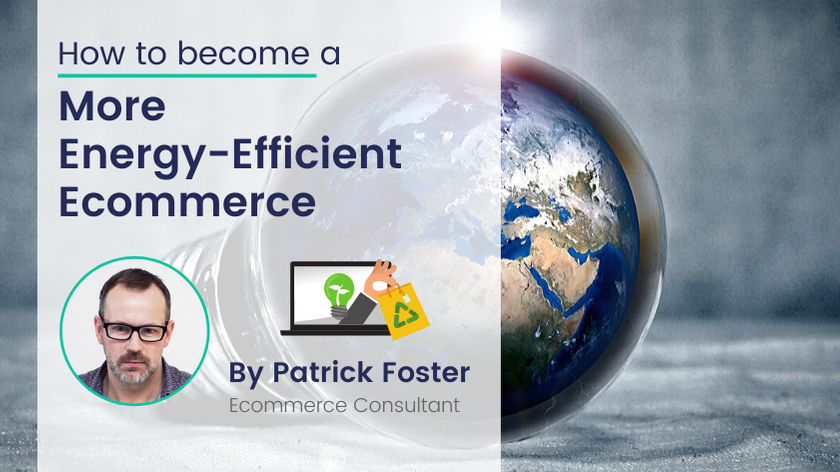Ecommerce companies are one of the most important business models currently and are booming. This model of purchase (online) is becoming the preferred by consumers. Due to this boom, Ecommerce business models not only see their facilities grow but also the energy consumption they require for their proper functioning. If you would like to become a more energy-efficient Ecommerce and you want to turn it into an example of efficiency and sustainability, here are 4 steps that will help you achieve it:
4 Steps to become a more Energy-Efficient Ecommerce
Which uses more energy on average: a traditional brick-and-mortar store, or an Ecommerce store? The truth is that it depends on the exact circumstances. People can often walk to physical stores to collect their products, which cuts down on shipping costs, and then there’s the matter of packaging waste. Every order sent out to an Ecommerce customer must be packaged individually. But then there’s the superior route-management inherent to cutting shopper journeys from the equation — e-commerce logistics can be highly sophisticated.
Regardless, a hot topic these days is rehabilitating technology, turning it from a source of pollution and damage to a driver of change and efficiency innovation. And with every brand under pressure to become more socially and environmentally responsible (younger generations demand it), the time is right to make a priority of cleaning up the world of business.
If you run an Ecommerce store, then, there are steps you can take to make your business more energy-efficient — saving you money and protecting the environment. Let’s review some:
1. Cut back on packaging waste
I mentioned packaging waste in the intro, and it’s a massive problem for huge retailers like Amazon. There are plenty of horror stories detailing small items (and not fragile ones) being shipped in gigantic cardboard boxes stuffed with packing peanuts. It takes energy to create that packaging, and more energy to transport it — larger boxes means fewer per trip and may demand larger (and more energy-hungry) vehicles.
The first thing you should do, then, is looking for ways in which you can make your packaging more economical and environmentally-friendly. Here are some tips:
- Review your product dimensions. As noted, it’s hugely wasteful to send a small item in a large box, so figure out the exact dimensions of your products and ship each order in the smallest-possible box (with only the padding truly required by the contents).
- Invest in 100%-recycled packaging. There are companies that exist solely to produce eco-friendly retail packaging. One such company, Earthface, has a dedicated Ecommerce lineup of envelopes and boxes. Find the best quote, and go green.
- Offer shipping alternatives. The basic delivery model isn’t the only viable approach. If you have physical premises, you can allow orders to be collected without any packaging directly from your building. If you don’t, you can establish agreements with small stores to ship your products to them for people to collect — when you can avoid packaging, do so, but even if you can’t, it’s more energy-efficient to have one large delivery to one pickup location than to have smaller deliveries to various addresses.
2. Raise funds for green energy
Knowing that your business activities have environmental consequences that you can’t fully prevent, you can make an effort to offset them — to find ways to encourage the generation of green energy to make up for the energy you’re using.
How you manage this as an ecommerce business is up to you. You can offer time and money to the green energy nonprofit of your choice, of course. You can run charity events to raise money. You can become more active on social media, using your platform to encourage your followers to participate in environmental-protection efforts (Earth Day is always great for this).
You can also work the fundraising into the fabric of your Ecommerce selling through providing an opt-in donation function in your checkout. WooCommerce (running on a WordPress platform) has the Woo Donations plugin allowing user-specific amounts to be added at the checkout, but if you want to get more in-depth with it, you should give Shopify a go — the free Carbon Checkout app provides a tracking code for each donation, allowing the customer to track their emission reductions and get a better idea of the real-world consequences of their environmental efforts.
There are also tools that will help you calculate the carbon footprint of your Ecommerce automatically. Calculate it and see how it evolves after the energy efficiency and sustainability actions you apply. An example of an App to calculate your company’s carbon footprint according to your energy consumption is the Carbon App that you will find in the Market Apps of DEXMA Energy Intelligence (an Energy Management Software). It will help you analyse and monitor your environmental impact, and you will be able to make it known to those who donated.

3. Allow more remote working
If your commerce company has staff, then you likely have an office — and if you do, the chances are good that some staff members drive to work, while others perhaps take public transport. This travel takes up energy that really isn’t justified in most cases. How often do your employees really need to be in the same location?
You run an Ecommerce company, after all. You don’t need shop assistants, or conventional shelf-stackers, or greeters, or security guards (outside of those at your warehouse). Most of your employees will be perfectly capable of doing their jobs from anywhere with internet access — typically preferring to work from home.
What’s more, people tend to have their homes heated and powered throughout the day, so it may well be more energy-efficient to have people work remotely than to gather them in a brightly-lit office. In short, remote working is better for energy-efficiency and morale.
4. Audit your premises
Whether you just rely on your stock-managed warehouses, or also maintain an office, you’re going to have a complex web of software systems and procedures underpinning your basic operation. The ecommerce process isn’t easy, and the more you implement automation tools and smart monitoring, the denser that web will become. This can start to use a lot of energy.
This is where DEXMA Energy Intelligence gets extremely useful. Offering a wide range of software and hardware integrations, as well as intuitive reporting, it makes it possible to fully review the energy efficiency of your entire operation, easily identifying opportunities to save money and start using less energy.
The bigger your business, the more room there’ll be for improvement, so why wait? The sooner you take the plunge, the sooner you can be running a business that’s both more profitable and better for the environment. It’s a classic win-win. And, if you need proof of this, have a look at a real successful case as “Privalia Case Study”. It’s a 2012 success story, but it’s still worth seeing as an example.
Energy-efficiency is a great thing for a business to aspire to, particularly when it’s rooted in online activity. If you can make a priority of cutting back on packaging waste, throwing your brand behind green energy in all possible ways, and getting your premises working more economically, you’ll get the results you’re looking for.

Patrick Foster is an Ecommerce entrepreneur, coach and writer. After several years as both a solopreneur and as a consultant to fellow Ecommerce entrepreneurs, Patrick’s sole focus now is his online resource and community hub, Ecommerce Tips.
Visit Patrick’s blog or follow him on Twitter @myecommercetips for the latest advice on Ecommerce, marketing, SEO, and how to develop your business strategy in these areas.




